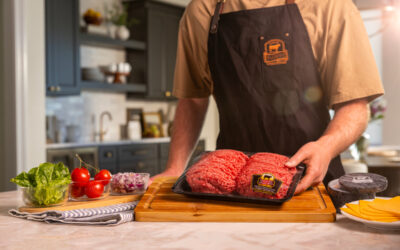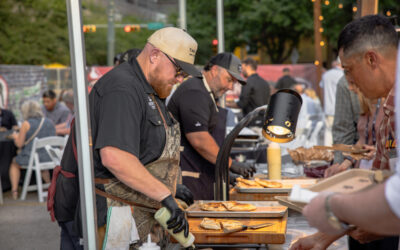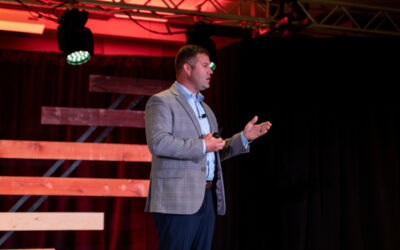
CARCASS DATA THAT MATTERS, PART II
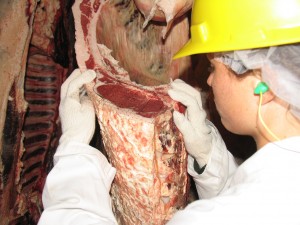
“This is a concrete measure of the size of one of the most valuable cuts of a beef carcass and, while not perfect, it’s a good indicator of overall carcass muscle content,” Paul says. “It’s most important when selling cattle on a carcass value-based system to maintain enough ribeye size in order to avoid Yield Grade discounts.”
Yield Grade is a measure of the relationship of subcutaneous fat to red meat yield. So, we’re shooting for more red meat yield and less subcutaneous fat and, consequently, larger ribeye areas.
The USDA grading service has a formula that indicates that a carcass of a certain weight should also have a ribeye area of a certain size. For instance, an 850-pound carcass should have a 14.0-inch ribeye. Any deviation from that 14.0-inch size will either indicate a higher than average amount of overall carcass muscling or a lower than average amount of muscling.
Consequently, the Yield Grade assigned to that carcass will reflect the positive or negative deviation from “average” and the producer will either receive a premium or a discount if the deviation is enough to warrant such an adjustment.
A cow-calf producer should strive to keep ribeye size somewhere between 12 to 16 inches, with the optimum being 12 to 14 inches for the end-users of our product.
Paul points out that restaurants and retailers generally favor ribeyes smaller than 14 inches, but he is not aware of a value-based payment system offered by any of the major packers that rewards the seller for these somewhat smaller ribeyes.
The Certified Angus Beef® brand requires ribeye size to be between 10 and 16 inches to qualify for the brand, so we’ve set a limit on both the lower and upper end of the scale to try to control variation in the size of important beef cuts.
Muscling also impacts dressing percentage, which measures final hanging carcass weight as a percentage of live weight. Higher muscle content, as well as subcutaneous fat content, positively impact dressing percentage. Higher dressing percentages mean more hanging weight which will be paid for on a grid pricing system. In the end, producers should strive to include muscling as criteria in selecting genetics, without going overboard, and while maintaining a balanced approach to evaluating all traits.
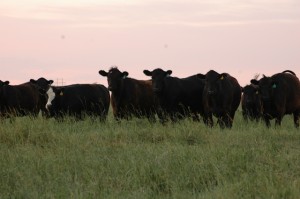
Paul explains that there is a diminishing point of returns at the ranch, where extremely heavily muscled cows will not re-breed and are inefficient. Therefore, balance is the key.
While backfat can have a significant impact on fed cattle value, Paul doesn’t think it’s an appropriate area to focus on when making herd decisions.
“I believe that the cow-calf producer’s job is to apply pressure to maintain muscling, which impacts Yield Grade directly, instead of selecting against backfat,” he says.
Indeed, less backfat has a positive impact on Yield Grades, but it also has a potential negative impact on cow efficiency and fertility.
“I think we have more important things to place focus on than backfat when using EPDs and Indexes, as long as the backfat EPD isn’t extremely high,” Paul says. “As well, if we get enough muscle in our cattle and manage their condition at the feedlot through nutrition and marketing cattle ‘on time’ when they reach 0.55 inches of backfat thickness, on average, we won’t have to worry about Yield Grade.”
Any questiongs about how to apply carcass data that we didn’t cover? Leave us a comment and we’ll get you the answer!
You may also like
Success, Despite Challenges
Today’s market is complex and competitive. The collective effort of stakeholders across the supply chain positions Certified Angus Beef to meet the record demand for premium beef moving forward. Signals across the beef industry are clear and Angus farmers and ranchers seeking high-quality genetics that deliver premium beef are producing a product in high demand.
Keep the Supply Coming
A record-high 800 registrants from 17 countries gathered in Austin, Texas, to learn more about CAB, become inspired by the culinary work of chefs and pitmasters, and celebrate sales and production success. But at the forefront: supply and demand, a reflection of the chaotic past year, and preparing for what’s ahead.
Consumer Demand, Power of Quality
Demand for high-quality beef persists. But with that demand comes challenges. From tight cattle supplies to higher costs and increasing pressure on retailers to deliver a consistent eating experience, the pressure is on. David O’Diam, CAB VP of retail, addressed the current retail beef environment, highlighting both opportunities and challenges in today’s marketplace.

